Grassweeds can be found in virtually every tillage field around the country and they vary in severity. When present in sufficient numbers, grassweeds can cause significant yield penalties and slow harvest progress.

It is increasingly important for growers to be able to identify the grass weeds present on their land.It is increasingly important for growers to be able to identify the grass weeds present on their land.
Effective control of grassweeds remains a challenge. And, given the fact that cereals are also grasses, herbicide control options are often limited.
In addition, the threat of herbicide resistance to our main herbicide groups, coupled with an ever-reducing pool of actives, means developing integrated control strategies based on chemical and cultural solutions must become common practice.
No matter what the control strategy, the ability to identify what species of grassweeds you are dealing with in your fields, particularly in the seedling stage, is vital.
Annual meadowgrass, bromes, canary grass, wild oats, common couch, meadow foxtail and blackgrass have all been identified on Irish farms in 2017.
While spring has gotten off to a slow start, the likelihood of any number of these weeds making an appearance this year is high. Therefore, knowing the key features of each grass species is crucial when walking your fields this spring.
Wild Oat
Avena fatua
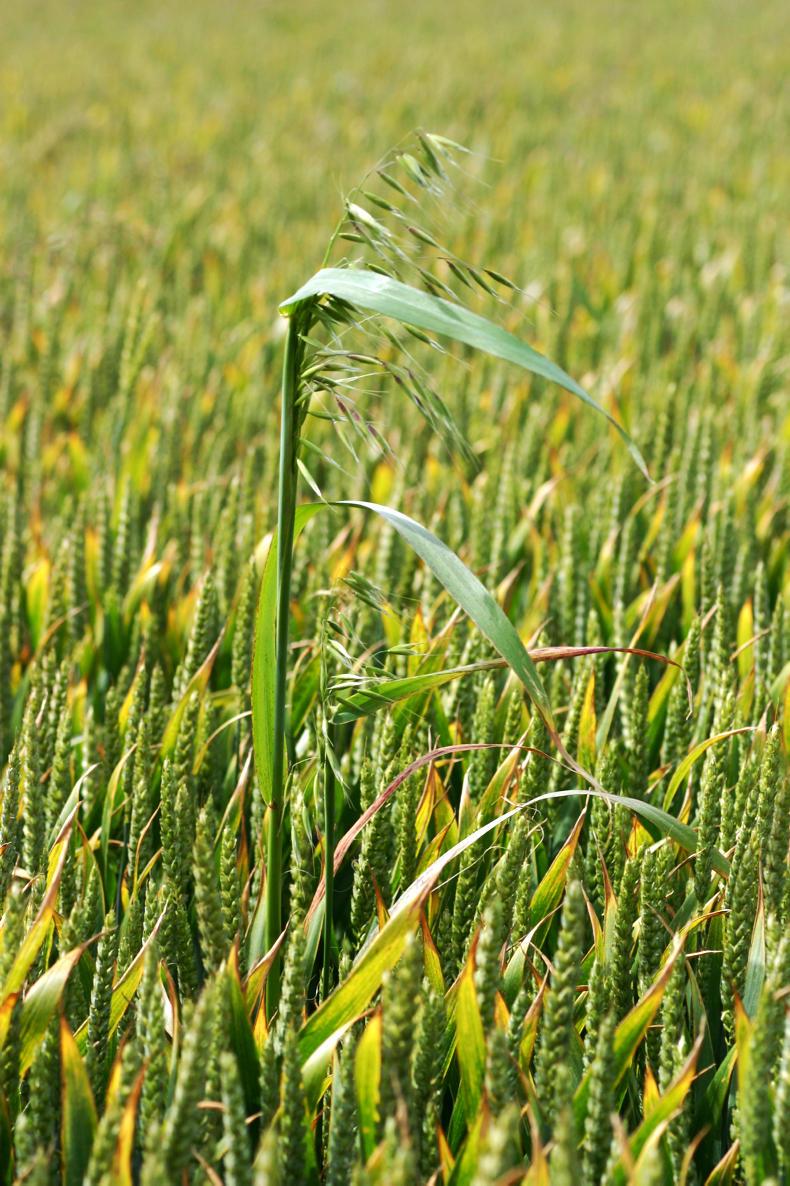
A distinctive single wild oat towering over cereals. A wild oats is a tall (30cm to 150cm), strong, stout, tufted grass with hollow stems. Wild oats reproduce only from seed which can be distinguished from conventional oats because of their darker appearance and the presence of a tuft of tawny hairs at the base.
Young plant: The seedling plant is similar in habit to cereals, but with an anticlockwise twist which is particularly apparent at leaves two to three. The leaves are sometimes rough to touch, are rolled in the sheath and are hairless.
Mature plant: A mature wild oat is tufted with tall upright stems and it quickly towers over cereals. It has a large, flat, rough leaf. The leaves have a distinctive anti-clockwise twist and the leaf margins are hairy towards the base. The ligule is long, up to 6mm in length, blunt and there are no auricles. The plant has a large spreading panicle of drooping pale green spikelets.
Commonly mistaken for: Cultivated oats at the seedling stage.
Sterile Brome
Anisantha sterilis
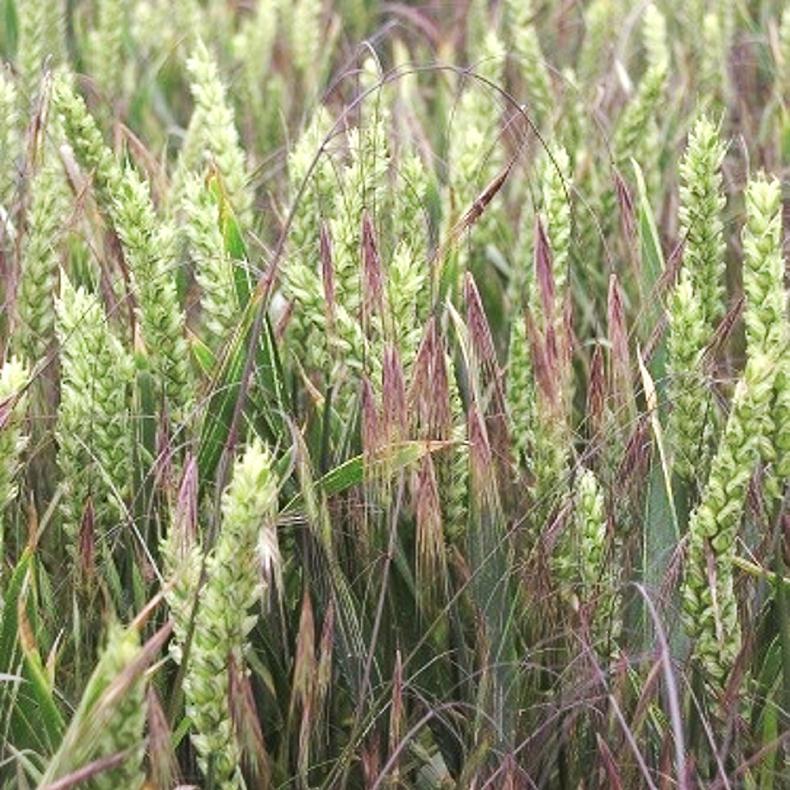
Sterile brome growing among winter wheat is often found in hedge rows and ditches. Sterile brome growing among winter wheat is often found in hedge rows and ditches.
Sterile (barren) brome is a native annual tufted grass species to Ireland that can grow to heights of 50cm to 100cm. The weed can often be found in hedgerows and ditches and moves into tillage fields via headland infestations.
Young plant: The first visible seedling leaf is purple-tinged, with the tillers turning a pale green colour. The leaf blade is hairy and finely pointed when extended. The ligule is of medium length and is deeply serrated. There are no auricles present.
Mature plant: The leaf blades are green, turning purple as they mature. The weed has very distinctive pyjame stripes on the lower leaf sheaths of sterile brome, as well as the small hairs on the sheath. The ligules are of medium length (4mm). The flower head is distinguished by its long awns and loose floppy panicles, which have a purple tinge. The spikelets are loosely scattered, drooping and contain between four to 10 seeds.
Commonly mistaken for: Great, meadow, rye and soft brome.
Blackgrass
Alopercurus myosuroides
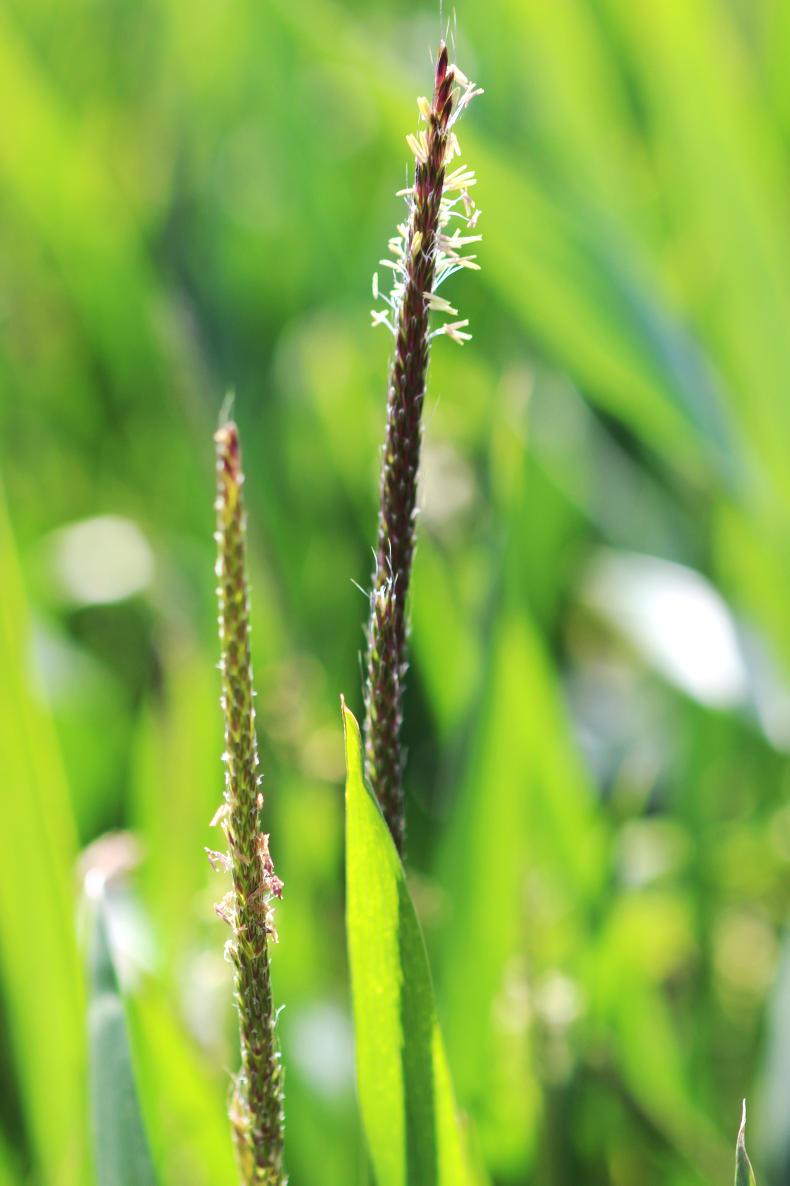
Blackgrass has distinctive, narrow, cylindrical heads which can be up to 13cm long and are a green to deep purple colour. Blackgrass is an annual tufted weed that can grow to heights of 80cm to 90cm. Blackgrass is one of the most significant cereal weeds due to its ability to spread, reduce crop yield and its known resistance to herbicides.
Young plant: The leaves are fine and smooth, with a shiny upper surface. The leaf blade is twisted, with a blunt tip and has a pronounced middle groove. The stem may be reddish in colour. The ligule is long and irregular. There are no auricles.
Mature plant: Mature plants have round slender stems, which are sometimes reddish. The leaves themselves are generally long, slender, shiny in the upper surface and dark green. The ligule is long, flat and ragged. The flower head is distinctive and resembles a rat tail. The narrow, cylindrical heads can be up to 13cm long and range from green to deep purple.
Commonly mistaken for: Loose silky bent at the young plant stage or meadow and marsh foxtail when flowering.
Annual Meadowgrass
Poa annua

Annual meadowgrass flower head is branched and spreading and is triangular in outline. Annual meadowgrass flower head is branched and spreading and is triangular in outline.
Annual meadowgrass (AMG) is a tufted annual or short-lived compact perennial, which grows to heights of 3cm to 30cm. AMG can complete its life cycle in as short as six weeks and spreads through seed and detached lateral roots.
Young plant: The first leaf grows vertically and tapers to a blunt point. It has a long ligule, 2mm to 5mm, roundly pointed and serrated with no auricles. The leaf shoot is folded and the leaf sheath flattened.
Mature plant: It has light green hairless leaves, with a distinctive curved tip (boat-shaped). The underside of the leaf has a distinctive central ridge, with a pair of parallel tramlines. The surface of the leaf is dull to shiny in colour and is sometimes crinkled or puckered.
The flowering head is branched and spreading and is triangular in outline. The spikelets are small and awnless with a pale whitish-green or purple colour.
Awned Canary Grass
Phalaris paradoxa

Awned canary grass flowerheads are broad and densely packed with spikelets which have green and white striped markings.Awned canary grass flowerheads are broad and densely packed with spikelets which have green and white striped markings.
Awned canary grass is a tall, tufted, annual grass that can grow to heights of 100cm. It is a freely tillering species and is competitive with cereal crops.
Young plant: The leaf blade is narrow and smooth and is rolled in the rounded sheaf. The first leaf sheath is a reddish brown colour. The ligule is long and pointed (3mm to 8mm) and has no auricle.
Mature plant: Mature plants are tall, up to 1m in height. The leaf blade is short, narrow, rough and flat. The sap from the stems is distinctively red. The stems of awned canary grass may spread along the ground before ascending. Flower heads vary in size, ranging from 1mm to 5.5mm in length and 8mm to 16mm wide. The flowerheads are upright, broad and densely packed with spikelets, which have green and white striped markings.
Commonly mistaken for: Meadow foxtail, lesser canary grass or timothy when flowering.
Common Couch
Elymus repens
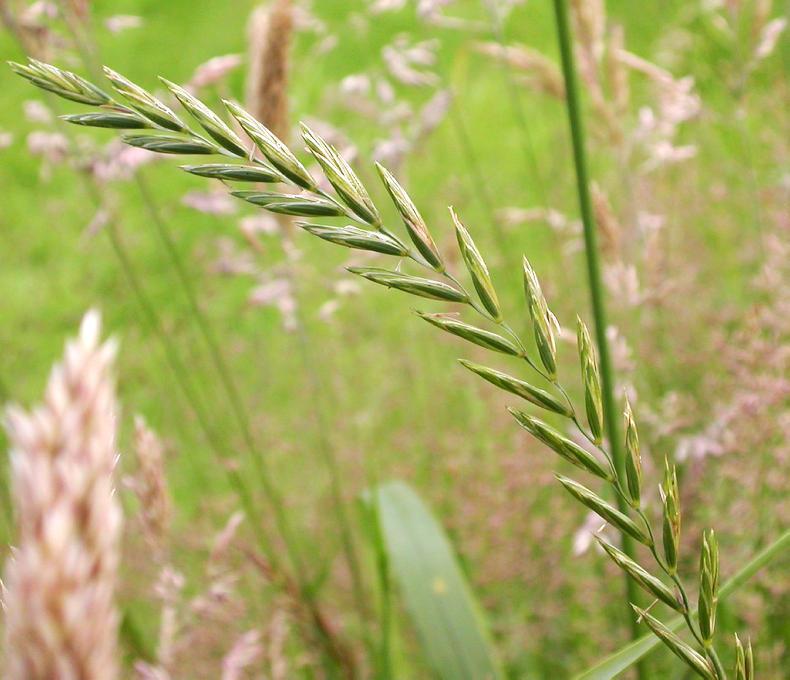
The spike or ear of common scutch grass showing the seed spikelets lying flat to the stem.The spike or ear of common scutch grass showing the seed spikelets lying flat to the stem.
Commonly known as scutch grass, this grass is a widely found perennial species. It is a vigorous grass, which can grow up to heights of 120cm and spread via creeping cord-like underground rhizomes.
Young plant: Seedlings are tall and have narrow dark-green tapering leafs with a sharp point. The leaves are rolled, hairy on the upper surface, with very short blunt ligules and short pointed auricles.
Mature plant: The leaf blade is dull green, long, flat and slightly keeled. The leaf surface is loosely hairy. The leaf sheath is rounded and the lower sheaths may be hairy. The ligule is very short (1mm) and blunt. The flowerhead is spike-shaped and varies in length. The spikelets are arranged in two alternative rows lying flat to the stem.
Commonly mistaken for: Ryegrass.
Meadow Foxtail
Alopecurus pratensis
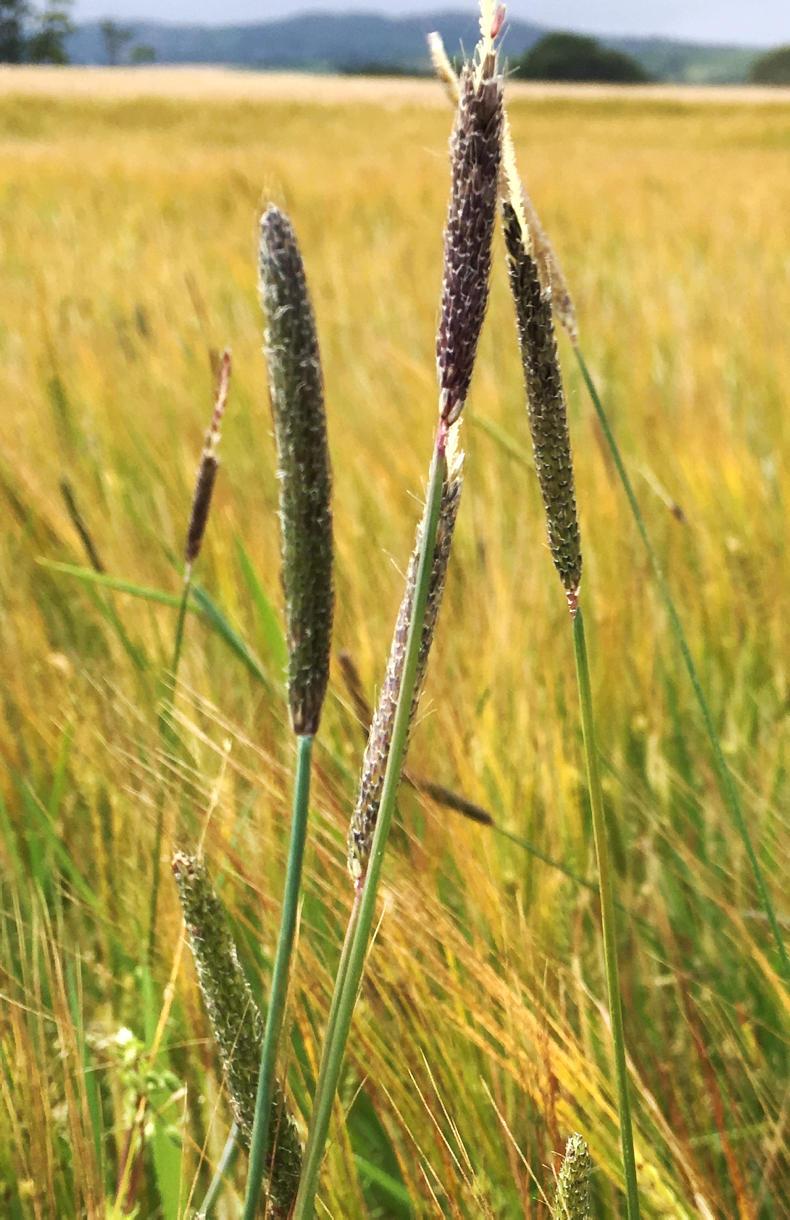
Meadow Foxtails long cylindrical flower head from which it gets its name 'foxtail'Meadow foxtail is an upright, moderately tall, tufted, leafy perennial, which can reach heights of 40cm to 100cm. The sheaths are smooth and cylindrical.
Young plant: Meadow foxtail seed germinates rapidly. The seedlings are small, quite weak and green in colour.
Mature plant: The leaf blade surface is smooth or slightly rough to the touch and rough on its lower surface. They are dull green in colour. The ligules are membranous and there are no auricles. The most distinctive feature of this grass is its long cylindrical flowerheads with short silky hairs from which it gets its name. They have a dense, cylindrical, greenish flowering head, with spikelets which have protruding silky awns.
Commonly mistaken for: Marsh foxtail, blackgrass and timothy when flowering.
Read more
Grassweeds – a challenge in all crops
Tillage management: Grassweeds need serious consideration on farms
Grassweeds can be found in virtually every tillage field around the country and they vary in severity. When present in sufficient numbers, grassweeds can cause significant yield penalties and slow harvest progress.

It is increasingly important for growers to be able to identify the grass weeds present on their land.It is increasingly important for growers to be able to identify the grass weeds present on their land.
Effective control of grassweeds remains a challenge. And, given the fact that cereals are also grasses, herbicide control options are often limited.
In addition, the threat of herbicide resistance to our main herbicide groups, coupled with an ever-reducing pool of actives, means developing integrated control strategies based on chemical and cultural solutions must become common practice.
No matter what the control strategy, the ability to identify what species of grassweeds you are dealing with in your fields, particularly in the seedling stage, is vital.
Annual meadowgrass, bromes, canary grass, wild oats, common couch, meadow foxtail and blackgrass have all been identified on Irish farms in 2017.
While spring has gotten off to a slow start, the likelihood of any number of these weeds making an appearance this year is high. Therefore, knowing the key features of each grass species is crucial when walking your fields this spring.
Wild Oat
Avena fatua

A distinctive single wild oat towering over cereals. A wild oats is a tall (30cm to 150cm), strong, stout, tufted grass with hollow stems. Wild oats reproduce only from seed which can be distinguished from conventional oats because of their darker appearance and the presence of a tuft of tawny hairs at the base.
Young plant: The seedling plant is similar in habit to cereals, but with an anticlockwise twist which is particularly apparent at leaves two to three. The leaves are sometimes rough to touch, are rolled in the sheath and are hairless.
Mature plant: A mature wild oat is tufted with tall upright stems and it quickly towers over cereals. It has a large, flat, rough leaf. The leaves have a distinctive anti-clockwise twist and the leaf margins are hairy towards the base. The ligule is long, up to 6mm in length, blunt and there are no auricles. The plant has a large spreading panicle of drooping pale green spikelets.
Commonly mistaken for: Cultivated oats at the seedling stage.
Sterile Brome
Anisantha sterilis

Sterile brome growing among winter wheat is often found in hedge rows and ditches. Sterile brome growing among winter wheat is often found in hedge rows and ditches.
Sterile (barren) brome is a native annual tufted grass species to Ireland that can grow to heights of 50cm to 100cm. The weed can often be found in hedgerows and ditches and moves into tillage fields via headland infestations.
Young plant: The first visible seedling leaf is purple-tinged, with the tillers turning a pale green colour. The leaf blade is hairy and finely pointed when extended. The ligule is of medium length and is deeply serrated. There are no auricles present.
Mature plant: The leaf blades are green, turning purple as they mature. The weed has very distinctive pyjame stripes on the lower leaf sheaths of sterile brome, as well as the small hairs on the sheath. The ligules are of medium length (4mm). The flower head is distinguished by its long awns and loose floppy panicles, which have a purple tinge. The spikelets are loosely scattered, drooping and contain between four to 10 seeds.
Commonly mistaken for: Great, meadow, rye and soft brome.
Blackgrass
Alopercurus myosuroides

Blackgrass has distinctive, narrow, cylindrical heads which can be up to 13cm long and are a green to deep purple colour. Blackgrass is an annual tufted weed that can grow to heights of 80cm to 90cm. Blackgrass is one of the most significant cereal weeds due to its ability to spread, reduce crop yield and its known resistance to herbicides.
Young plant: The leaves are fine and smooth, with a shiny upper surface. The leaf blade is twisted, with a blunt tip and has a pronounced middle groove. The stem may be reddish in colour. The ligule is long and irregular. There are no auricles.
Mature plant: Mature plants have round slender stems, which are sometimes reddish. The leaves themselves are generally long, slender, shiny in the upper surface and dark green. The ligule is long, flat and ragged. The flower head is distinctive and resembles a rat tail. The narrow, cylindrical heads can be up to 13cm long and range from green to deep purple.
Commonly mistaken for: Loose silky bent at the young plant stage or meadow and marsh foxtail when flowering.
Annual Meadowgrass
Poa annua

Annual meadowgrass flower head is branched and spreading and is triangular in outline. Annual meadowgrass flower head is branched and spreading and is triangular in outline.
Annual meadowgrass (AMG) is a tufted annual or short-lived compact perennial, which grows to heights of 3cm to 30cm. AMG can complete its life cycle in as short as six weeks and spreads through seed and detached lateral roots.
Young plant: The first leaf grows vertically and tapers to a blunt point. It has a long ligule, 2mm to 5mm, roundly pointed and serrated with no auricles. The leaf shoot is folded and the leaf sheath flattened.
Mature plant: It has light green hairless leaves, with a distinctive curved tip (boat-shaped). The underside of the leaf has a distinctive central ridge, with a pair of parallel tramlines. The surface of the leaf is dull to shiny in colour and is sometimes crinkled or puckered.
The flowering head is branched and spreading and is triangular in outline. The spikelets are small and awnless with a pale whitish-green or purple colour.
Awned Canary Grass
Phalaris paradoxa

Awned canary grass flowerheads are broad and densely packed with spikelets which have green and white striped markings.Awned canary grass flowerheads are broad and densely packed with spikelets which have green and white striped markings.
Awned canary grass is a tall, tufted, annual grass that can grow to heights of 100cm. It is a freely tillering species and is competitive with cereal crops.
Young plant: The leaf blade is narrow and smooth and is rolled in the rounded sheaf. The first leaf sheath is a reddish brown colour. The ligule is long and pointed (3mm to 8mm) and has no auricle.
Mature plant: Mature plants are tall, up to 1m in height. The leaf blade is short, narrow, rough and flat. The sap from the stems is distinctively red. The stems of awned canary grass may spread along the ground before ascending. Flower heads vary in size, ranging from 1mm to 5.5mm in length and 8mm to 16mm wide. The flowerheads are upright, broad and densely packed with spikelets, which have green and white striped markings.
Commonly mistaken for: Meadow foxtail, lesser canary grass or timothy when flowering.
Common Couch
Elymus repens

The spike or ear of common scutch grass showing the seed spikelets lying flat to the stem.The spike or ear of common scutch grass showing the seed spikelets lying flat to the stem.
Commonly known as scutch grass, this grass is a widely found perennial species. It is a vigorous grass, which can grow up to heights of 120cm and spread via creeping cord-like underground rhizomes.
Young plant: Seedlings are tall and have narrow dark-green tapering leafs with a sharp point. The leaves are rolled, hairy on the upper surface, with very short blunt ligules and short pointed auricles.
Mature plant: The leaf blade is dull green, long, flat and slightly keeled. The leaf surface is loosely hairy. The leaf sheath is rounded and the lower sheaths may be hairy. The ligule is very short (1mm) and blunt. The flowerhead is spike-shaped and varies in length. The spikelets are arranged in two alternative rows lying flat to the stem.
Commonly mistaken for: Ryegrass.
Meadow Foxtail
Alopecurus pratensis

Meadow Foxtails long cylindrical flower head from which it gets its name 'foxtail'Meadow foxtail is an upright, moderately tall, tufted, leafy perennial, which can reach heights of 40cm to 100cm. The sheaths are smooth and cylindrical.
Young plant: Meadow foxtail seed germinates rapidly. The seedlings are small, quite weak and green in colour.
Mature plant: The leaf blade surface is smooth or slightly rough to the touch and rough on its lower surface. They are dull green in colour. The ligules are membranous and there are no auricles. The most distinctive feature of this grass is its long cylindrical flowerheads with short silky hairs from which it gets its name. They have a dense, cylindrical, greenish flowering head, with spikelets which have protruding silky awns.
Commonly mistaken for: Marsh foxtail, blackgrass and timothy when flowering.
Read more
Grassweeds – a challenge in all crops
Tillage management: Grassweeds need serious consideration on farms














 This is a subscriber-only article
This is a subscriber-only article



















SHARING OPTIONS: